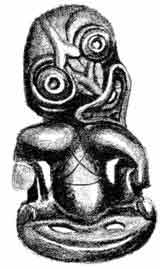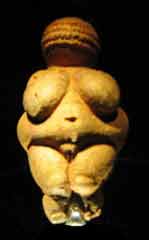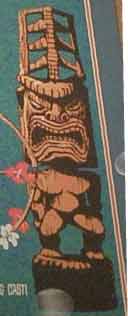
THE
ANCIENT
Weapons, Tikis AND
Society OF Hawaii
Hawaiian
History
& Culture
Hawaiian
Tiki
Gods
Tiki
Tiki Tiki!
Tiki's
and Tiki Culture History
I
can almost understand if someone doesn't share my interest in ancient
Hawaii, but if some doesn't like Tiki's theirs just something plain
wrong with them. How in the name of the Gods can someone not be fascinated
by those piercing, knowing eyes and that menacing grin that seems to
let lose a silent ancestral roar! Tiki's speak of an enchanted ancient
time through a wooden or stony disposition, a dark distant past that's
hard for a man to look at, and even harder to look away from. Tiki statues,
poles, masks and the whole genre are a fascinating look into human creativity,
emotions and origins. If that sound grandiose, well, try arguing with
the fact that they are fun. I'm waiting…

Hei-tiki
drawing
of a 19th century
Mauri Hei-tiki ornamental
neck pendant
Ancient Tiki's: Origins
Carving is one of man oldest known art form, a 25,000 year old stone statue has been found (The pop polynesian like Venus of Willendorf), only cave paintings are older and they were usually done in relief. Wood carving certainly predates the Venus, however wood items tend to degrade and we would be extremely lucky to find an early example. I would even venture a guess that if we did find one it would resemble tikis. Across the world examples carved idols blossomed. From the pagans of Europe to the totems of the American Northwest, tiki's styles flourished and their idols were worshipped by tribal men. For thousands of years these images of gods were revered. However the most enduring style of ancient figure carving is perhaps that of the Polynesians. The giant heads of Easter Island, Mauri pendants and the ancient Hawaiian poles that marked sacred areas all sprouted from a common seed. Using Stone Age technology and all of the ingenuity of modern man, Polynesians created a lasting style.
Venus of
Willendorf
Tiki's Appear: Ice age art
c. 23,000 BC
On December 7th, 1934 Don the Beachcomber (Don Beach) opened a Polynesian themed restaurant in Hollywood California. They served Cantonese cuisine and tropical rum punches with decor featuring carved tiki's, masks, flaming torches, rattan furniture, flower leis and brightly colored fabrics. Others, like Trader Vic, began to copy the Polynesian theme. When the American soldiers returned home from the south pacific theatre of World War II they brought with them stories and souvenirs from Oceania. The America became enthralled with a romanticized version of Polynesia and the popularity of everything Polynesian skyrocketed. This romanticized version of Polynesia permeated American culture effecting its home decor, music, clothing and architecture. Polynesian music was in fused with jazz, Asian music, African rhythms, and Latin creating hybrid sounds like “jungle”. Films such as The Jaguar God came out of Hollywood where a strange Tarzan like tribal genre was created. The musical South Pacific was preformed in theatres through out the eras of high tiki. Tiki's popularity peaked out in the late 50’s and early 60’s marked by Hawaii becoming a state (1959) and some very bad Elvis movies. Tiki bars, attractions like Disney’s Enchanted Tiki's Room and all of tiki's culture had become wildly popular. However by the early 70’s the culture had become a victim of its own success. Over exposure had rendered it cliché and kitschy. It seemed Tiki’s long and wild success had ended but the scowling gods had quite another idea…

Hawaiian
Style
Pop Art
Hawaiian theames
penetrated American
Art
and Society
c.1965 AD

Yard Statue
c. 2006 A.D.
Hawaiiana
Return of the Tikis! The Renaissance
Beginning in the late
1980's the culture has enjoyed resurgence. Tropical mugs, bars, torches
have once again become popular. Tradal
Hawaiian tattoos have also returned, an ancient tradition
in Polynesia. The reasons very widely. Some collect objects of the lowly
kitsch culture due to their camp value, while others pursue a more profound
interest in the original Polynesian culture. Nostalgia also plays a role;
older people remember the high times, while younger people remember their
parents bamboo bars and tropical parties. I have also heard that the culture
is an escape, a way for modern man to forget his woes amongst misty rum
drinks, mood lighting bamboo lamps or torches, tapa clothe and of course,
the scowling carved gods! Others may claim that the postmodern movement
has blurred the lines between eras, allowing people to grab ideas from any
era or culture. Still others feel it harkens back to mans inner tribal roots,
an umbilical cord through time that often comes with rum. What is clear,
however, is that the culture is making a come back and it's long, storied
history will continue for a very long time indeed! The Scowling Gods will
not allow themselves to be forgotten! Copyright
© 2006 MythicHawaii.com